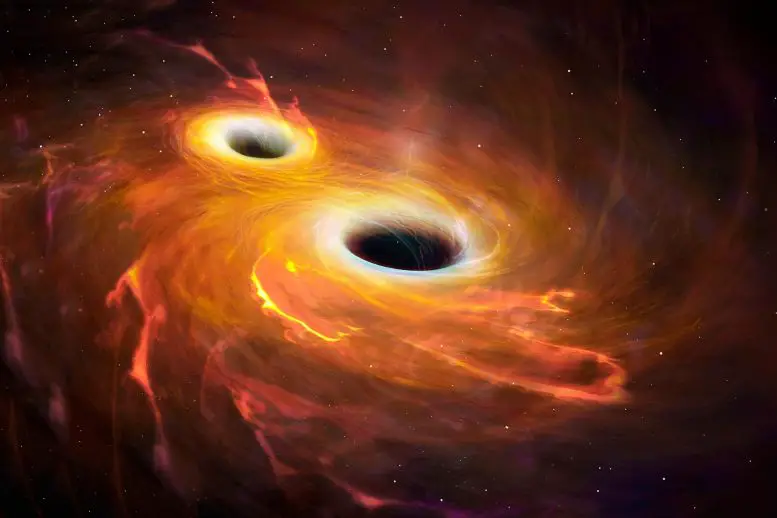NASA’nın Chandra X-ışını Gözlemevi, cüce gökadalarda çarpışma rotalarında iki çift süper kütleli kara delik tespit etti ve bu, böyle yaklaşan bir karşılaşmanın ilk kanıtı. Bu keşif, erken evrenin karadelik büyümesi hakkında çok önemli bilgiler sağlar.
- Milky Way, likely formed larger galaxies through collisions in the early Universe.
- These newly-discovered merging dwarf galaxies can be used as analogs for more distant ones that are too faint to observe.
- The dwarf galaxies are on collision courses and are found in the galaxy clusters Abell 133 and Abell 1758S.

Evidence for two pairs of supermassive black holes in dwarf galaxies on collision courses has been found with Chandra. The two pairs are shown in X-rays from Chandra and optical light from the Canada-France-Hawaii telescope. The merger on the left is in a late stage and was given the single name of Mirabilis. The other merger is in the early stages and the two dwarf galaxies are named Elstir (bottom) and Vinteuil (top). Astronomers think that dwarf galaxies – those about 20 times less massive than the Milky Way – grow through mergers with others. This is an important process for galaxy growth in the early Universe and this discovery provides examples for scientists to study in greater detail. Credit: X-ray: NASA/CXC/Univ. of Alabama/M. Micic et al.; Optical: International Gemini Observatory/NOIRLab/NSF/AURA
A new study using NASA’s Chandra X-ray Observatory has tracked two pairs of supermassive black holes in dwarf galaxies on collision courses. This is the first evidence for such an impending encounter, providing scientists with important information about the growth of black holes in the early Universe.
By definition, dwarf galaxies contain stars with a total mass less than 3 billion Suns — or about 20 times less than the Milky Way. Astronomers have long suspected that dwarf galaxies merge, particularly in the relatively early Universe, in order to grow into the larger galaxies seen today. However, current technology cannot observe the first generation of dwarf galaxy mergers because they are extraordinarily faint at their great distances. Another tactic — looking for dwarf galaxy mergers closer by — had not been successful to date.
Yeni çalışma, derin Chandra X-ışını gözlemlerinin sistematik bir araştırmasını uygulayarak ve bunları NASA’nın Geniş Kızılötesi Araştırma Gezgini’nden (WISE) gelen kızılötesi verilerle ve Kanada-Fransa-Hawaii Teleskobu’ndan (CFHT) gelen optik verilerle karşılaştırarak bu zorlukların üstesinden geldi.
Chandra bu çalışma için özellikle değerliydi çünkü karadelikleri çevreleyen malzeme milyonlarca dereceye kadar ısıtılarak büyük miktarlarda X-ışınları üretilebilir. Ekip, iki kara deliğin kanıtı olarak çarpışan cüce galaksilerde parlak X-ışını kaynağı çiftleri aradı ve iki örnek keşfetti.

Chandra ile cüce galaksilerde çarpışma rotalarında iki çift süper kütleli kara delik olduğuna dair kanıt bulundu. İki çift, Chandra’dan gelen X ışınlarında ve Kanada-Fransa-Hawaii teleskobundan gelen optik ışıkta gösteriliyor. Soldaki birleşme geç bir aşamada ve Mirabilis’in tek adı verildi. Diğer birleşme erken aşamalarda ve iki cüce gökada Elstir (altta) ve Vinteuil (üstte) olarak adlandırılıyor. Gökbilimciler, Samanyolu’ndan yaklaşık 20 kat daha az kütleli olan cüce gökadaların başkalarıyla birleşme yoluyla büyüdüğünü düşünüyor. Bu, erken Evren’deki galaksi büyümesi için önemli bir süreçtir ve bu keşif, bilim adamlarının daha ayrıntılı olarak çalışabileceği örnekler sağlar. Kredi: Röntgen: NASA/CXC/Univ. Alabama/M. Miciç ve diğerleri; Optik: Uluslararası İkizler Gözlemevi/NOIRLab/NSF/AURA
Bir çift, soldaki bileşik görüntüde görülen, Dünya’dan 760 milyon ışıkyılı uzaklıkta bulunan Abell 133 gökada kümesindedir. Chandra X-ray verileri pembe renkte ve CFHT’den gelen optik veriler mavi renktedir. Bu cüce gökada çifti, bir birleşmenin son aşamalarında gibi görünüyor ve çarpışmanın gelgit etkilerinin neden olduğu uzun bir kuyruk gösteriyor. Yeni çalışmanın yazarları, nesli tükenmekte olan bir hayvandan sonra ona “Mirabilis” adını verdiler.[{” attribute=””>species of hummingbird known for their exceptionally long tails. Only one name was chosen because the merger of two galaxies into one is almost complete. The two Chandra sources show X-rays from material around the black holes in each galaxy.

X-ray and optical composite of Mirabilis. Credit: X-ray: NASA/CXC/Univ. of Alabama/M. Micic et al.; Optical: International Gemini Observatory/NOIRLab/NSF/AURA
The other pair was discovered in Abell 1758S, a galaxy cluster about 3.2 billion light-years away. The composite image from Chandra and CFHT is on the right, using the same colors as for Mirabilis. The researchers nicknamed the merging dwarf galaxies “Elstir” and “Vinteuil,” after fictional artists from Marcel Proust’s “In Search of Lost Time”. Vinteuil is the galaxy on the top and Elstir is the galaxy on the bottom. Both have Chandra sources associated with them, again from X-rays from material around the black holes in each galaxy. The researchers think these two have been caught in the early stages of a merger, causing a bridge of stars and gas to connect the two colliding galaxies from their gravitational interaction.

X-ray and optical composite of Elstir & Vinteuil. Credit: X-ray: NASA/CXC/Univ. of Alabama/M. Micic et al.; Optical: International Gemini Observatory/NOIRLab/NSF/AURA
The details of merging black holes and dwarf galaxies may provide insight to our Milky Way’s own past. Scientists think nearly all galaxies began as dwarf or other types of small galaxies and grew over billions of years through mergers. Follow-up observations of these two systems will allow astronomers to study processes that are crucial for understanding galaxies and their black holes in the earliest stages of the Universe.
Bu sonuçları açıklayan bir makale en son sayısında yayınlandı. bu Astrofizik Dergisi.
Referans: Marko Mićić, Olivia J. Holmes, Brenna N. Wells ve Jimmy A. Irwin, 22 Şubat 2023, “Cüce-Cüce Galaksi Birleşmelerinde İkili AGN için İki Aday”, Astrofizik Dergisi.
DOI: 10.3847/1538-4357/aca1bb
Çalışmanın yazarları, tümü Tuscaloosa’daki Alabama Üniversitesi’nden Marko Micic, Olivia Holmes, Brenna Wells ve Jimmy Irwin’dir.
NASA’nın Marshall Uzay Uçuş Merkezi, Chandra programını yönetiyor. Smithsonian Astrofizik Gözlemevi’nin Chandra X-ray Merkezi, Cambridge, Massachusetts’teki bilim operasyonlarını ve Burlington, Massachusetts’teki uçuş operasyonlarını kontrol ediyor.

